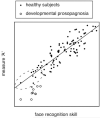The problem of being bad at faces
- PMID: 27312748
- PMCID: PMC4996721
- DOI: 10.1016/j.neuropsychologia.2016.06.008
The problem of being bad at faces
Abstract
Developmental prosopagnosia has received increased attention in recent years, but as yet has no confirmed genetic or structural markers. It is not certain whether this condition reflects simply the low-end of the spectrum of normal face recognition, an 'under-development', or a pathologic failure to develop such mechanisms, a 'mal-development'. This difference in views creates challenges for the diagnosis of developmental prosopagnosia by behavioural criteria alone, which also vary substantially between studies, with secondary effects on issues such as determining its prevalence. After review of the literature and the problems inherent to diagnoses based solely on behavioural data, we propose as a starting discussion point a set of two primary and four secondary criteria for the diagnosis of developmental prosopagnosia.
Keywords: Development; Diagnosis; Face recognition; Perception; Prosopagnosia.
Copyright © 2016 Elsevier Ltd. All rights reserved.
Figures


References
-
- Avidan G, Hasson U, Malach R, Behrmann M. Detailed exploration of face-related processing in congenital prosopagnosia: 1. functional neuroimaging findings. J Cogn Neurosci. 2005;17:1150–1167. - PubMed
-
- Baron-Cohen S, Wheelwright S, Skinner R, Martin J, Clubley E. The autism-spectrum quotient (AQ): evidence from Asperger syndrome/high-functioning autism, males and females, scientists and mathematicians. J Autism Dev Disord. 2001;31:5–17. - PubMed
-
- Barsics C, Bredart S. Recalling semantic information about newly learned faces and voices. Memory. 2012;20:527–534. - PubMed
-
- Barton J, Cherkasova M, O’Connor M. Covert recognition in acquired and developmental prosopagnosia. Neurology. 2001;57:1161–1167. - PubMed
Publication types
MeSH terms
Grants and funding
LinkOut - more resources
Full Text Sources
Other Literature Sources
Research Materials

